|
|
|
Sort Order |
|
|
|
Items / Page
|
|
|
|
|
|
|
| Srl | Item |
| 1 |
ID:
187148
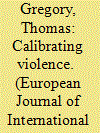

|
|
|
|
|
| Summary/Abstract |
This article examines how coalition forces sought to weaponise the counting of civilian casualties in Afghanistan between 2008 and 2014. Drawing on interviews with senior coalition officials, recently declassified documents, and coalition data on civilian harm, it will explain how these figures were used to calibrate the violence inflicted on the Afghan people, ensuring that commanders applied sufficient force to achieve their objectives without causing unnecessary harm to civilians and jeopardising the success of military operations. The article examines the formation of the Civilian Casualty Tracking Cell (CCTC), which was created by General David McKiernan in 2008. It also traces the formation of the Civilian Casualty Mitigation Team (CCMT), which was established by General John Allen in 2011. Furthermore, it explores how this data was deployed by coalition officials to minimise civilian harm where possible and to rationalise this harm where necessary. Rather than simply documenting the death and destruction, these counts were complicit in the violence experienced by Afghan civilians, helping to enable and enhance the effectiveness of military operations. As such, I argue that these counts failed to contest the violence of war or the continued dehumanisation of Afghan civilians.
|
|
|
|
|
|
|
|
|
|
|
|
|
|
|
|
| 2 |
ID:
172430
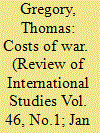

|
|
|
|
|
| Summary/Abstract |
Coalition forces have spent upwards of $50 million on condolence payments to Afghan and Iraqi civilians. These condolence payments were intended as an expression of sympathy rather than an admission of fault, and the programme itself has been criticised for the arbitrary, inconsistent, and low valuation of civilian lives. Rather than focus on the practical problems associated with condolence payments or normative arguments about whether belligerents ought to compensate those harmed, this article will trace the strategic imperatives that underpinned this programme and shaped its development. As coalition forces began to recognise the strategic costs of civilian casualties, they used a variety of tactics to mitigate the effects of civilian casualties on the success of military operations. This article will argue that condolence payments should not be seen as a humanitarian gesture designed to recognise and respond to the suffering of ordinary civilians, but will argue that condolence payments should be viewed as a weapons system aimed at securing specific military goals. As such, this article will argue that condolence payments continued to objectify and devalue the lives of Afghans and Iraqis by treating them as a means to an end rather than an end in themselves.
|
|
|
|
|
|
|
|
|
|
|
|
|
|
|
|
| 3 |
ID:
165015
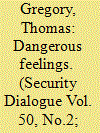

|
|
|
|
|
| Summary/Abstract |
Between 2006 and 2007 an average of one Iraqi civilian was killed or injured at a coalition checkpoint each day. In many cases, civilians were shot because soldiers had misinterpreted their behaviour as hostile or as a demonstration of hostile intent. In other words, the soldiers responsible thought that they were acting in self-defence against an imminent threat. Some analysts have argued that these killings can be explained by ambiguities in the rules of engagement, but such explanations wrongly assume that the decision to kill is a purely rational calculation. Drawing upon the work of Sara Ahmed, William Connolly and George Yancy, I will argue that the interpretation of hostile intent and the decision to use lethal force are affective judgements rather than purely conscious decisions and, as such, are shaped by feelings, moods and intuitions. Moreover, I will argue that these judgements are never entirely neutral but clouded by a set of pre-existing assumptions that mark certain bodies as dangerous before they even have a chance to act. Drawing upon an archive of incident reports filed in the aftermath of these shootings and interviews with former soldiers, this article will show how seemingly innocuous behaviours were so readily mistaken for hostile acts with decidedly deadly consequences for the local population.
|
|
|
|
|
|
|
|
|
|
|
|
|
|
|
|
| 4 |
ID:
141297
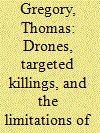

|
|
|
|
|
| Summary/Abstract |
The debate about drones has largely taken place on a legal terrain with various politicians, lawyers, and activists all seeking to establish whether or not targeted killings are legal under the existing framework of international law. In particular, they have raised concerns about the geographical and temporal scope of the “war on terror,” the legal status of those being targeted and whether or not these strikes can be considered discriminate, proportionate, and necessary. The aim of this article is not to settle these legal questions once and for all but to think about the limitations of framing the use of drones as a legal issue rather than an ethical, moral, or political concern. I will argue that the emphasis on international law distracts attention away from the horrors of war by masking the pain and suffering that is caused in favor of technical debates about the application of particular legal codes. Drawing on the work of Judith Butler, Adriana Cavarero, and Elaine Scarry, I will argue that we need to turn our attention back to the embodied experiences of those affected.
|
|
|
|
|
|
|
|
|
|
|
|
|
|
|
|
| 5 |
ID:
153884
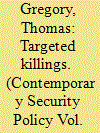

|
|
|
|
|
| Summary/Abstract |
The use of drones to kill suspected militants seems to provide a simple technical fix to a complex ethico-political problem: the need to discriminate between combatants and noncombatants. The technological ability of drones, combined with the rhetorical commitment to reducing civilian casualties, suggests that the principle of noncombatant immunity is firmly entrenched in debates about targeted killings. However, this article will argue that a peculiar effect of this enhanced technological capability has been to draw attention to the conceptual confusion that surrounds the distinction. Rather than assuming that it is a fixed feature of international law, I will argue that it should be viewed as a discursive formation that is contingent upon a precarious process of repetition and reiteration. Moreover, I will show how the laws designed to restrain the violence inflicted on civilian bodies have been invoked to render certain civilians vulnerable, constituting them as killable, their lives profoundly losable.
|
|
|
|
|
|
|
|
|
|
|
|
|
|
|
|
|
|
|
|
|